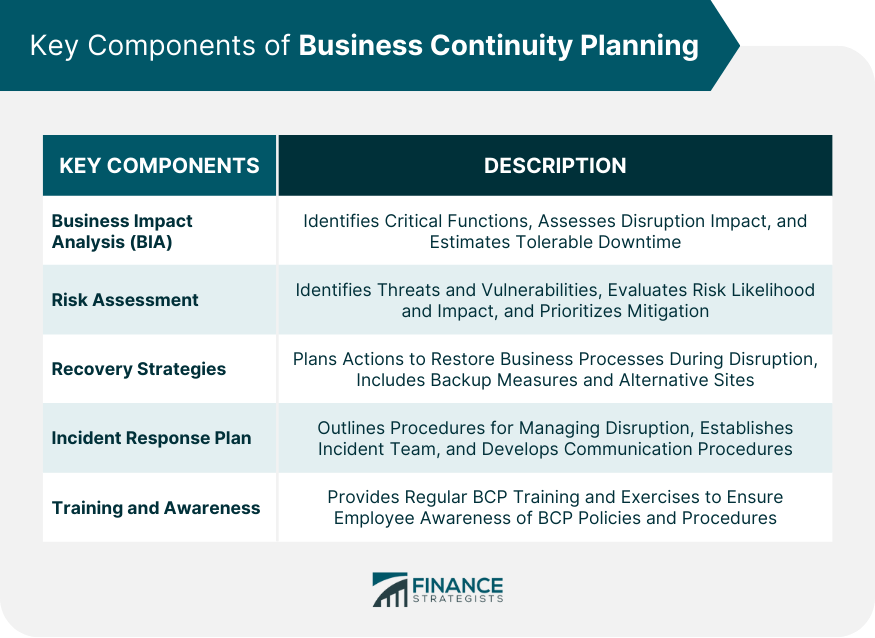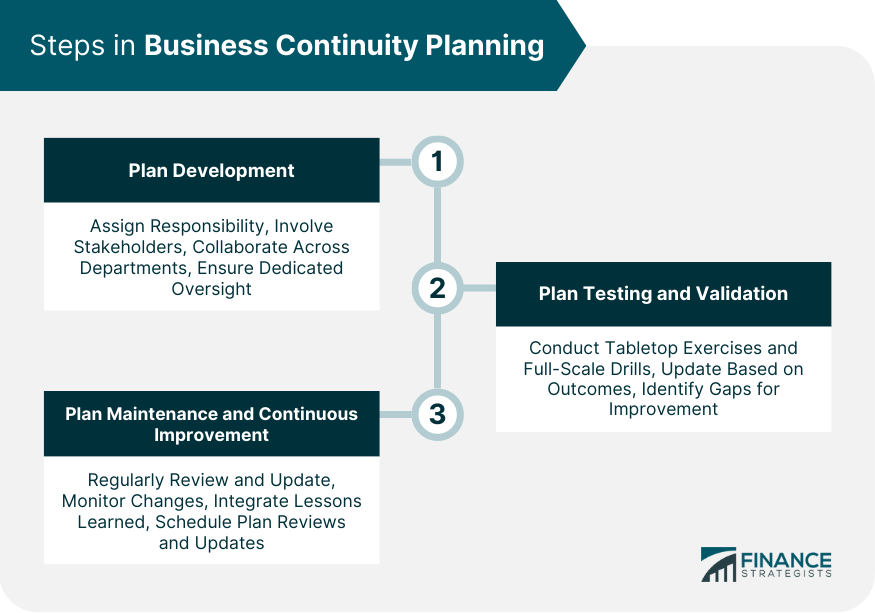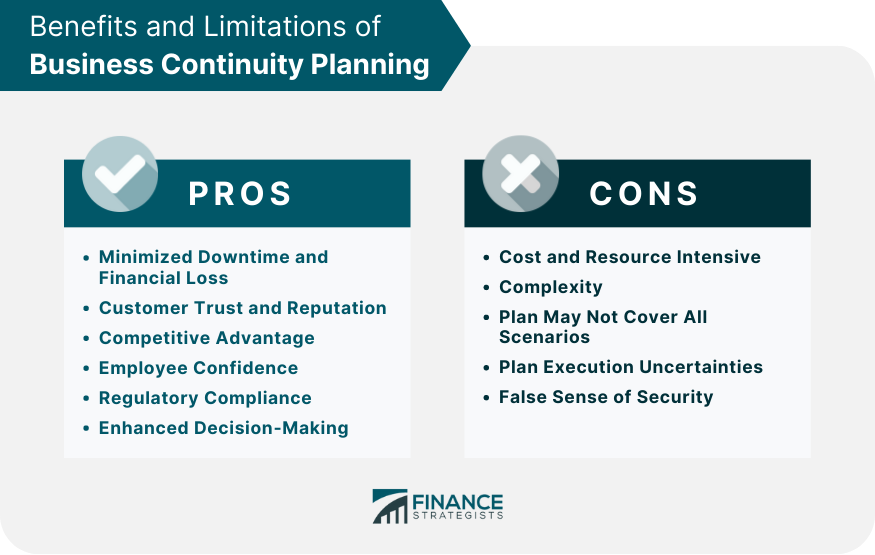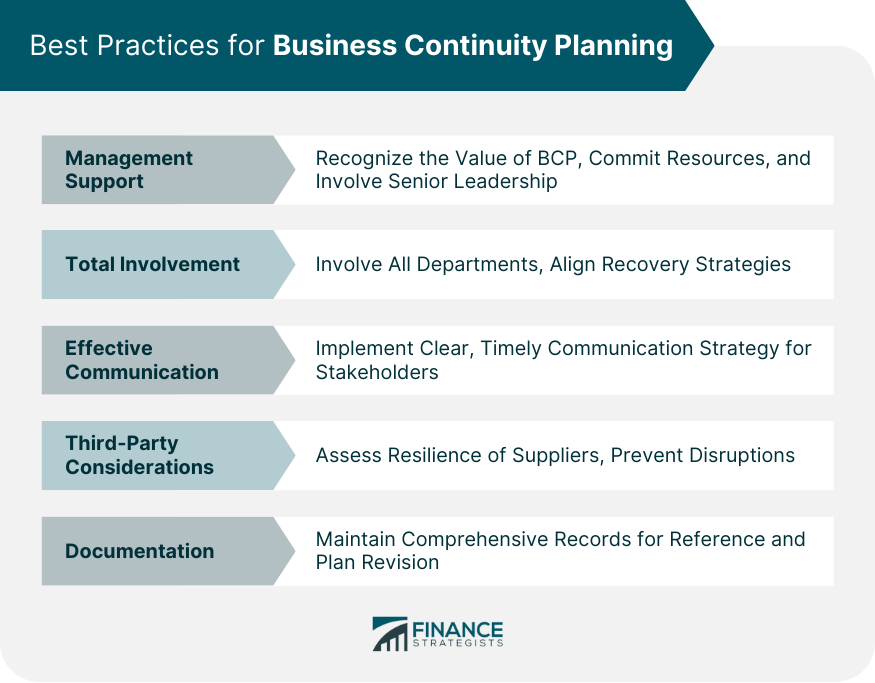Business Continuity Planning refers to the process of creating and implementing strategies and measures that ensure an organization can continue its essential operations and deliver critical services in the event of a disruptive incident. BCP aims to minimize the impact of potential threats, such as natural disasters, cyberattacks, or operational failures, on the organization's ability to function. The primary objective of BCP is to establish resilient systems and procedures that allow businesses to recover quickly and efficiently from any significant disruption. This involves identifying potential risks, assessing their potential impact, and developing strategies to mitigate those risks. BCP typically includes measures like creating backup systems, implementing data recovery processes, establishing alternate work locations, and developing communication plans. By developing a robust BCP, organizations can ensure the safety of their employees, maintain customer trust and satisfaction, minimize financial losses, and comply with regulatory requirements. It is an ongoing process that requires regular review, testing, and updates to adapt to changing circumstances and emerging threats.
A Business Impact Analysis involves identifying critical business functions and processes, assessing the potential impact of disruptions, and estimating the maximum tolerable downtime for each process. This helps organizations prioritize their resources and determine appropriate recovery strategies. The BIA process often includes interviews with key personnel, surveys, and data analysis to gather information about the organization's business processes, dependencies, and potential consequences of disruptions. This information forms the foundation for developing risk mitigation strategies and allocating resources to protect critical business functions. Risk Assessment is the process of identifying potential threats and vulnerabilities, evaluating the likelihood and impact of risks, and prioritizing them for mitigation and response. This information is crucial for developing effective recovery strategies and allocating resources efficiently. A comprehensive risk assessment involves analyzing potential risks from various sources, such as natural disasters, human-made incidents, and technological failures. By understanding these risks' likelihood and potential impact, organizations can make informed decisions about where to invest in prevention, response, and recovery measures. Recovery strategies are the plans and actions taken to restore business processes during a disruption. This includes developing strategies for business process recovery, implementing backup and redundancy measures, and establishing alternative operational sites if necessary. Organizations can choose from various recovery strategies, such as redundancy, backup systems, alternative locations, and remote work arrangements. The choice of recovery strategies depends on factors such as the organization's size, industry, regulatory requirements, and available resources. An Incident Response Plan outlines the procedures and responsibilities for managing a disruption. This includes establishing an incident management team, defining roles and responsibilities, and developing communication and notification procedures. The Incident Response Plan should be detailed, outlining clear steps for responding to various types of incidents. It is essential to include procedures for coordinating with external stakeholders, such as first responders, suppliers, and customers, and internal communication processes to keep employees informed and engaged during a disruption. Regular BCP training and exercises are essential to ensure employees know BCP policies and procedures. This helps to incorporate BCP into the organization's culture, making it more resilient and adaptable in the face of disruptions. Training and awareness programs may include workshops, simulations, and e-learning courses that cover topics such as emergency procedures, communication protocols, and the roles and responsibilities of employees during an incident. By fostering a culture of preparedness, organizations can improve their ability to respond effectively to disruptions and maintain business continuity. Conducting BCP involves assigning responsibility for plan development and management, establishing a project timeline and milestones, and involving key stakeholders in the planning process. A successful BCP development process requires collaboration across departments and functions, ensuring that all perspectives and concerns are considered. Additionally, assigning a dedicated team or individual to oversee BCP development and implementation can help ensure that the plan remains on track and meets the organization's needs. This can be done through tabletop exercises and full-scale drills helps to evaluate its effectiveness and identify areas for improvement. Updating the plan based on test outcomes ensures that it remains relevant and functional. Tabletop exercises are discussion-based simulations that allow participants to walk through various scenarios and evaluate the effectiveness of the BCP. On the other hand, full-scale drills are live simulations that test the organization's ability to execute the BCP under realistic conditions. Both types of exercises provide valuable insights and help identify gaps or areas for improvement in the plan. Regularly reviewing and updating the BCP, monitoring changes in the business environment, and integrating lessons learned from tests and real-world incidents contribute to continuous improvement and ensure that the plan remains effective. To maintain an effective BCP, organizations should establish a schedule for regular plan reviews and updates, considering changes in business operations, technology, and regulatory requirements. Additionally, after-action reviews following tests and real-world incidents can provide valuable insights for improving the plan and strengthening the organization's resilience. For businesses, downtime can have severe financial implications - from loss of revenue to additional costs related to recovery and rebuilding. A well-conceived BCP outlines the strategies and measures necessary to keep critical functions running or to quickly resume them after a disruptive event. It helps organizations maintain their cash flow, protect financial stability, and avoid the potential loss of market share to competitors. Customers expect reliable and uninterrupted services and even a minor disruption can lead to dissatisfaction, damaging the company's reputation. A robust BCP allows a company to maintain or quickly resume its services during a crisis, which is essential for customer retention and long-term loyalty. This continued service reliability fosters trust among clients and maintains the company's reputation, which can be a critical differentiating factor in the marketplace. When disruptions occur, organizations with a comprehensive BCP in place can maintain operations and continue providing services, while competitors may struggle. This readiness positions a company as reliable and resilient, which can attract new customers and strengthen relationships with existing ones. An effective BCP demonstrates to employees that their organization is well-prepared for potential disruptions. This transparency can reduce panic and confusion, thereby increasing employee confidence and productivity in stressful situations. It also signals the company's commitment to employee welfare and job security, which can contribute to increased job satisfaction and retention. In many industries, such as finance, healthcare, and energy, regulatory bodies mandate business continuity planning to protect consumers and maintain industry stability. A comprehensive BCP ensures that organizations meet these regulatory requirements, preventing potential penalties, sanctions, or legal actions. It also demonstrates the organization's commitment to best practices, which can foster trust among clients and stakeholders. A well-structured BCP includes clear protocols and procedures for various disruptive scenarios, reducing ambiguity and confusion. This clarity allows the management team to quickly understand the situation, make informed decisions, and take appropriate actions without delay. By enhancing response time and efficiency, a BCP minimizes the negative impacts of a crisis and hastens recovery. Conducting thorough risk assessments and business impact analyses, creating the plan, ensuring its alignment with the organization's goals, and training employees can all be resource-intensive activities. Regular testing, maintenance, and updating of the plan can also incur substantial costs over time. For small to medium enterprises (SMEs) with limited resources, these expenses can be significant and may impede the implementation of a comprehensive BCP. This complexity stems from the need to deeply understand various business processes, operational dependencies, and potential risks. Ensuring that every department, function, or operation is adequately represented in the BCP can be challenging. It also necessitates collaboration and coordination across different teams and levels of the organization, adding to the overall complexity. While a well-constructed BCP is developed based on an extensive risk assessment, it's virtually impossible to predict and plan for all potential disruptions. Organizations are susceptible to unforeseen disruptions due to the uncertain and ever-changing nature of risks. This is particularly evident in our interconnected world, where new threats can arise that were not originally considered during the planning stage. Even with a robust BCP in place, uncertainties during its execution in a real-world crisis can pose challenges. Despite training and preparation, human error, stress-induced mistakes, miscommunication, or unforeseen complications can impede the successful execution of the plan. These uncertainties underline the need for regular testing and revision of the plan and its procedures. This is a potential psychological drawback of having a BCP. There's a risk that the existence of the plan could lead to complacency, with individuals assuming they are entirely protected from disruptions. This mindset can reduce alertness to new threats and hamper the organization's agility and responsiveness. Management must recognize the value of BCP and commit to its implementation, ensuring that the necessary resources, both human and financial, are dedicated to the planning process. Moreover, the involvement of the senior leadership team demonstrates the importance of the plan to the entire organization, reinforcing commitment across all levels. BCP should encompass all departments and functions within the organization. Representatives from every department, including operations, HR, finance, and IT, should be involved in the planning process. This comprehensive approach ensures that the plan covers all critical functions and that recovery strategies are aligned across the entire business. A comprehensive communication strategy should be in place, detailing how and when information will be communicated to employees, customers, suppliers, stakeholders, and potentially the media. Clear, timely, and accurate communication can help to minimize confusion and misinformation and maintain trust during a disruption. The continuity planning of your suppliers, service providers, and partners can have a significant impact on your organization. Therefore, part of your BCP should involve understanding and evaluating the resilience of key third parties. This will help to ensure that their potential weaknesses or failures do not disrupt your operations. This includes records of risk assessments and BIAs, continuity strategies, training materials, and records of updates and changes to the plan. Comprehensive documentation serves as a valuable reference guide during a crisis and aids in the training, testing, and revision of the plan. Business Continuity Planning is a critical process that organizations must undertake to ensure the continuity of their operations and the delivery of vital services during disruptive incidents. By implementing strategies and measures to minimize potential threats, organizations can recover quickly and efficiently from significant disruptions. BCP encompasses components such as business impact analysis, risk assessment, recovery strategies, incident response planning, and training programs. It offers numerous benefits, including minimizing downtime and financial losses, maintaining customer trust and reputation, gaining a competitive advantage, boosting employee confidence, ensuring regulatory compliance, and enhancing decision-making. Despite potential drawbacks such as costs and complexities, organizations can overcome them through management support, total involvement from all departments, effective communication strategies, considerations for third-party resilience, and comprehensive documentation. By prioritizing BCP and incorporating it into their organizational culture, businesses can effectively respond to crises, protect their reputation, and thrive in a dynamic business environment.What Is Business Continuity Planning (BCP)?
Key Components of Business Continuity Planning
Business Impact Analysis (BIA)
Risk Assessment
Recovery Strategies
Incident Response Plan
Training and Awareness

Steps in Business Continuity Planning
Plan Development
Plan Testing and Validation
Plan Maintenance and Continuous Improvement

Benefits of Business Continuity Planning
Minimized Downtime and Financial Loss
Customer Trust and Reputation
Competitive Advantage
Employee Confidence
Regulatory Compliance
Enhanced Decision-Making
Limitations of Business Continuity Planning
Cost and Resource Intensive
Complexity
Plan May Not Cover All Scenarios
Plan Execution Uncertainties
False Sense of Security

Best Practices for Business Continuity Planning
Management Support
Total Involvement
Effective Communication
Third-Party Considerations
Documentation

Final Thoughts
Business Continuity Planning (BCP) FAQs
Business Continuity Planning is an organization's proactive process to identify potential threats and impacts to its operations. It provides a framework for building resilience and the capacity for an effective response that safeguards the interests of key stakeholders, reputation, brand, and value-creating activities.
BCP is crucial because it enhances an organization's ability to continue operations during or after a disruption or disaster. It minimizes downtime, reduces the scope of disruption, and provides a planned recovery path, thus protecting the organization from significant financial loss and reputational damage.
Key components of BCP include Business Impact Analysis (identifying critical functions and their dependencies), Recovery Strategies (defining how to recover critical functions), Plan Development (writing the plan), and Testing and Exercises (evaluating the plan's effectiveness and making necessary adjustments).
A BCP should be reviewed and updated regularly to ensure its effectiveness. The frequency can depend on the organization's operations, technology, personnel, or physical location changes. However, as a best practice, reviewing and updating the BCP at least annually or whenever significant changes occur is recommended.
While the responsibility can vary depending on the size and structure of the organization, typically, a designated Business Continuity Manager or a team is responsible for BCP. However, it's important to note that successful business continuity planning requires support and involvement from top management and participation across all levels of the organization.
True Tamplin is a published author, public speaker, CEO of UpDigital, and founder of Finance Strategists.
True is a Certified Educator in Personal Finance (CEPF®), author of The Handy Financial Ratios Guide, a member of the Society for Advancing Business Editing and Writing, contributes to his financial education site, Finance Strategists, and has spoken to various financial communities such as the CFA Institute, as well as university students like his Alma mater, Biola University, where he received a bachelor of science in business and data analytics.
To learn more about True, visit his personal website or view his author profiles on Amazon, Nasdaq and Forbes.











